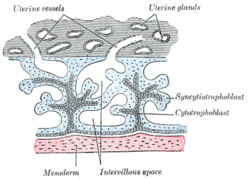Cytotrophoblast
| Cytotrophoblast | |
|---|---|

Primary chorionic villi. Diagrammatic.
|
|

Secondary chorionic villi. Diagrammatic.
|
|
| Details | |
| Carnegie stage | 5a |
| Days | 8 |
| Identifiers | |
| Latin | cytotrophoblastus |
| MeSH | A16.254.085.162 |
| TE | E6.0.1.1.4.0.5 |
| FMA | 83039 |
|
Anatomical terminology
[]
|
|
The cytotrophoblast (or layer of Langhans) is the inner layer of the trophoblast. It is interior to the syncytiotrophoblast and external to the wall of the in a developing embryo.
The cytotrophoblast is considered to be the trophoblastic stem cell because the layer surrounding the blastocyst remains while daughter cells differentiate and proliferate to function in multiple roles. There are two lineages that cytotrophoblastic cells may differentiate through: fusion and invasive. The fusion lineage yields syncytiotrophoblast and the invasive lineage yields interstitial cytotrophoblast cells.
Cytotrophoblastic cells play an important role in the implantation of a newly fertilized egg in the uterus.
The formation of all syncytiotrophoblast is from the fusion of two or more cytotrophoblasts via this fusion pathway. This pathway is important because the syncytiotrophoblast plays an important role in fetal-maternal gas exchange, nutrient exchange, and immunological and metabolic functions.
An undifferentiated cytotrophoblastic stem cell will differentiate into a villous cytotrophoblast, which is what constitutes primary chorionic villi, and will eventually coalesce into villous syncytiotrophoblast. The formation of syncytiotrophoblast from cytotrophoblast is a terminal differentiation step of trophoblastic cells.
Syncytialization of cytotrophoblastic cells can be induced in vitro through multiple signalling molecules including epidermal growth factor, glucocorticoids, and human chorionic gonadotropin.
The invasive lineage creates cytotrophoblasts that are essential in the process of implantation and forming a fully functional placenta. An undifferentiated cytotrophoblastic stem cell will differentiate into an extravillous cytotrophoblast intermediate and then into an interstitial cytotrophoblast. An interstitial cytotrophoblast may then further differentiate into an endovascular cytotrophoblast or form a syncytium.
The primary function of an interstitial cytotrophoblast is to anchor the growing fetus to the maternal uterine tissue. These cells may invade the whole endometrium and the proximal third of the myometrium.
...
Wikipedia
